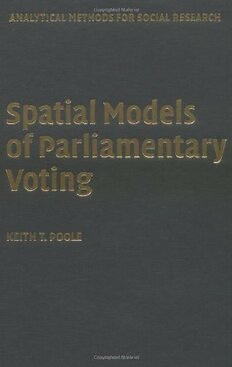
Spatial Models of Parliamentary Voting (Analytical Methods for Social Research) PDF
250 Pages·2005·4.107 MB·English
Most books are stored in the elastic cloud where traffic is expensive. For this reason, we have a limit on daily download.
Preview Spatial Models of Parliamentary Voting (Analytical Methods for Social Research)
Description:
This book presents a geometric voting model for analyzing parliamentary roll call data. Each legislator is represented by one point and each roll call is represented by two points that correspond to the policy consequences of voting Yea or Nay. On every roll call each legislator votes for the closer outcome point, at least probabilistically. These points form a spatial map that summarizes the roll calls. In this sense a spatial map is much like a road map because it visually depicts the political world of a legislature. These maps can be used to study a wide variety of topics related to legislative voting.
See more
The list of books you might like
Most books are stored in the elastic cloud where traffic is expensive. For this reason, we have a limit on daily download.
